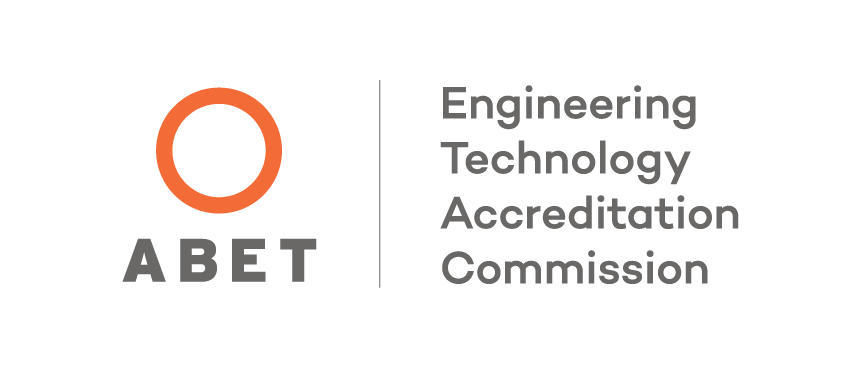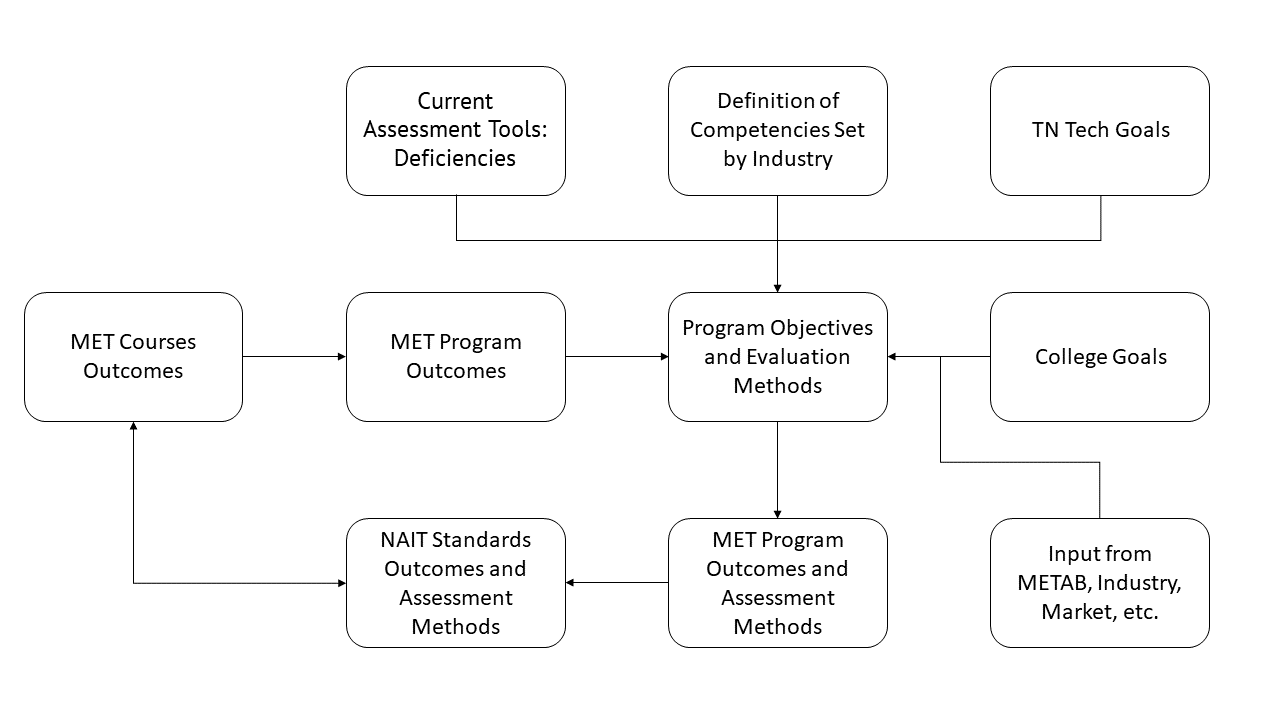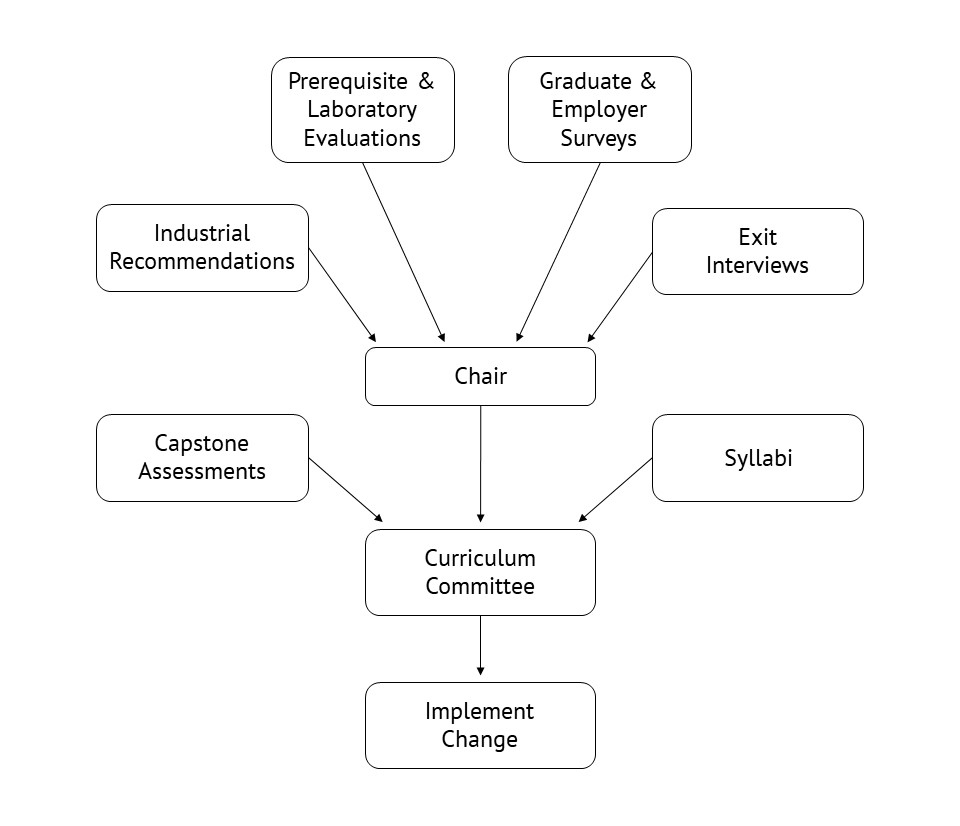Manufacturing and Engineering Technology
Enrollment & Graduation Rates
| Year | Enrollment (Fall census) |
Degrees Conferred (7/01 - 6/30) |
| 2014-15 | 231 | 53 |
| 2015-16 | 245 | 58 |
| 2016-17 | 234 | 68 |
| 2017-18 | 244 | 71 |
| 2018-19 | 219 | 74 |
| 2019-20 | 228 | 62 |
| 2020-21 | 217 | 62 |
| 2021-22 | 211 | Not yet available |
The Bachelor of Science in Engineering Technology (BSET) is accredited by the Engineering Technology Accreditation Commission of ABET https://www.abet.org

Program Outcomes & Assessment
Assessment
Assessment Plan and Integration: An assessment plan shall be comprised of, but not limited to, the following for each program: (1) program mission statement, (2) the desired program outcomes/learning outcomes, (3) evidence that the program incorporates these outcomes/student competencies, (4) the assessment measures used to evaluate student mastery of the student competencies stated, (5) compilation of the results of the assessment measures, and (6) evidence that these results are used to improve the program.
Mission
To graduate innovative Engineering Technologists who solve technological challenges to meet societal needs.
Desired Program Outcomes and Learning Outcomes as Instituted by Tech
The program outcomes and learning outcomes are identified by the department. The program outcomes are applicable to the general Department of Manufacturing and Engineering Technology at Tech. The faculty identified the applicable learning outcomes for each course. From this group, each instructor listed the assessment methods used in the course to measure each outcome. These methods, as instituted by Tech academic affairs, are described under assessment procedures and detailed as follows:
Departmental Plans for Student-Outcomes Goals, Assessment Methods, and Strategic Goals
The following Students-Outcomes Goals, Assessment Methods, and Strategic Goals are in compliance with Tech academic affairs.
Current Student-Outcome Goals
A. Current Student-Outcome Goal 1
Students completing the baccalaureate program in engineering technology will be well prepared for entry into the technical areas of industry. The graduates of the technology program are interviewed to determine their preparation for the jobs in manufacturing industry. This information is gathered by the results of an alumni survey conducted every five years. Also, this survey provides any additional information relating to any changes needed by the technology program. This goal is achieved by providing students with a strong technical background, which is applicable to technology.
B. Current Student-Outcome Goal 2
The recent alumni survey provided the information to determine the skills required for conducting their daily tasks. In a descending order they are:
- Oral communications and human relations skills;
- Use of technological skills;
- Computer applications skills;
- Hands-on skills;
- Written communication skills;
- Management/supervision skills;
- Mathematical skills, and
- Use of physical science and mathematical skills.
Guided by the results of the alumni survey, the students exit interview and after consultation with the Manufacturing and Engineering Technology Advisory Board (METAB), technical communication is adopted in almost every course taught in the department in the form of oral presentations of projects and written reports. Oral and written communications were addressed in almost every MET courses, particularly in the MET 2615 - Engineering Technology Ethics and Professionalism and MET 4620 - Senior Projects courses. These competencies were developed to meet the needs of technology students by incorporating various types of technical reports and specific oral presentations common to industry. By using the information from the alumni survey and the input from METAB, several types of reports were suggested to be sure the students would have a wide variety of assignments relating to reports used in technical positions. This interest is maintained by using specialized assignments adopted by people from industry.
2. Evidence that the Program Incorporates these Students Learning Outcomes
Curriculum Organization - Courses are developed around a solid foundation of basic objectives. Other courses are built from this foundation as prerequisites. Several technical areas are covered in the laboratory courses of the department. Several specialized laboratories are required to complement the course offerings. Curriculum requirements are reviewed by alumni surveys, comments by industry, and suggestions from the advisory board.
3. Assessment Measures Used to Evaluate Student Mastery of the Stated Students Learning Outcomes
Beside the Tech instituted assessment, the MET program utilizes a variety of techniques to obtain feedback on students' progress and achievement in the major. Techniques may be formal or informal and each provides valuable information for program evaluation and development. The overall assessment strategy is based on several formal and informal techniques. The following figure shows the relationship between the courses outcomes, the program outcomes and the program objectives.
Program Assessment Procedure (See Figure 1)
- METAB input for the program outcomes and students competencies;
- Faculty discussed these outcomes/ competencies periodically;
- Students gave their inputs at the exit interviews;
- Mission statement revised;
- Educational objectives and expected outcomes developed; and
- Curriculum revised for contribution to outcomes determined after consultation with MITAB.

Figure 1 - ET Program Assessment Dynamics used by the Department of Manufacturing and Engineering Technology
Assessment Tools
Students' course assessment - IDEA Assessment is used by the institution to evaluate the instruction of every course for the tenure track faculty and two courses per year for the tenured faculty. This standardized course assessment includes:
- Overall Measures of Teaching Effectiveness - Provides global assessment of teaching effectiveness;
- Student Ratings of Progress on Relevant Objectives - Provides student-report of learning on objectives identified as relevant (Important or Essential) by the instructor;
- Course Description/Context - Primarily to assist in interpreting the results by considering the context in which the course was taught; and
- Statistical Detail - Primarily to provide details, which may help the faculty and his/her consultants to understand or interpret the report accurately.
Faculty course assessment - The instructors use many different methods to evaluate the assessment criteria in each course. These criteria would include class discussions, laboratory exercises, student interaction, problem solving, online assignments, written reports, oral presentations, exams, role playing graphic aids, teamwork projects, etc.
Senior Project course experience assessment - This senior capstone course has been identified by the Engineering Technology community as a valuable element of the assessment process. This course is becoming more popular in assessing the behavioral and cognitive achievement. This course was developed several years ago to assist the department in the analysis of the technical management understanding of the students before graduation. The course requires a solution to real world problem, which is identified by industry and students in a written proposal format approved by industry, the students and the senior faculty advisor. In conjunction with the project phases, a written paper and public oral presentation are completed for evaluation by a jury of faculty advisor and industry advisor. The capstone model was selected because of the value added to the undergraduate student's education while supplying meaningful assessment data. Students are advised that the Industrial Project should demonstrate the full breadth of their education with emphasis on the specific outcomes being used for program assessment.
Students seek an industrial partner during their senior year and identify a substantial but surmountable "real world" problem, then together with the faculty advisor determine the scope of work. Toward the end of the semester, the students submit a final written report and make a major public presentation before jury consisting of classmates, faculty and industrial partners. Desired program outcomes are integrated into the course criteria and into the evaluation as part of the assessment plan such as:
The project must demonstrate aspects of technical and project management competency. Students must choose a project that will prepare them for their roles as technical managers.
The project must demonstrate:
- Ability to work in a team environment - Students typically work in teams of two to three students;
- Ability to apply the knowledge they acquired during their course of study;
- Ability to identify, formulates, and solve a real world problem;
- Ability to communicate effectively; and
- Recognition of the need for, and ability to engage in life-long learning
Exit Interview of graduating seniors - The exit interviews are conducted every semester and administered by the chairperson of the department to all graduating seniors. Specific questions relating to instruction, laboratory activities and student interests are noted. A careful examination of this information can help evaluate instruction in the department, determine the applicability of laboratory activities relating to the goals of the course, emphasis of lecture versus laboratory activities, and other important aspects in the daily operation of the department.
ATMAE certification Examination - This is a standardized test developed by ATMAE. It is relevant to the program core educational objectives and outcomes, available for senior students to take without requiring on-the-job experience, provide feedback to the teaching faculty on how the program's students did overall on the exam compared to other program's students and on the different subject areas covered in the exam, reasonably priced, and available each semester. This exam is used to benchmark the Tech student against similar programs across the country.
Manufacturing and Engineering Technology Advisory Board Comments - Since the advisory board is a good cross section of industry represented by individual members of manufacturing, sales, engineering and design, it is a good sounding board for determining important information in the upgrading of the curriculum to represent modern technology. This modern technology can be transferred to objectives of our courses. As technology changes, new courses must be developed to reflect these modern concepts. (PLC, Rapid Prototyping, ProE, Geometry Dimensioning and Tolerancing, Tool Design, to name a few).
College Base examination - The College Base examination is used to assess Tech's general education. It is required of all students obtaining their first undergraduate degree from Tech. The exam is offered in the fall and spring semesters. Students should take the exam one semester prior to their anticipated graduation date. All summer graduates must take the exam during a spring semester. This exam tests four Subject Scores: English, mathematics, science, and social studies; and three Competency Scores: interpretive, strategic, and adaptive reasoning.
Employer's Evaluation of Co-op Students - This evaluation entails:
- Attitude-Application to Work;Initiative;
- Maturity-Poise;
- Ability to Learn;
- Quality of Work;
- Quantity of Work;
- Dependability;
- Relations with Others;
- Judgment;
- Attendance;
- Punctuality; and
- Overall performance
1. Five years Alumni Survey
The alumni survey was emailed out during the spring semester of 2020. The questions
were directed to obtain information related to instruction, appropriate laboratory
equipment, and relevant curriculum. Also, basic employment information was obtained
for the Alumni Office from this survey.
2. Compilation of the results of the Assessment Measures
The assessment measures results are compiled and used to improve the program on a
regular basis. Toward the end of the fall and spring semesters, the department collect
the: 1) students course assessments, 2) faculty course assessment, 3) Industrial Project
course experience assessment, 4) exit interviews of graduating seniors, 5) Manufacturing
and Engineering Advisory Board comments, 6) college base examination, 7) ATMAE Certification
examination results, and 8) Employer's evaluation of Co-op Students. Every five years,
the department conducts an alumni survey. The results of the assessment measures are
found either in the body of this report or in the appendices. The following item shows
how the results of the assessment measures are used to improve the program.
3. Evidence that these results are used to improve the program
The faculty were asked to identify competencies which could be used as the MET program
assessment tool for each of their courses. A list of competencies was developed by
the faculty to insure that all areas would be identified for each individual course.
Each faculty member checked the specific competencies that would be applicable to
his course. After they were identified, an explanation was given as to the type of
assessment technique used to evaluate that competency. According to the recent alumni
survey, the competencies required for conducting their daily tasks and assessment
tools for each course are listed here.
4. MET-Program Curriculum Continuous Improvement Plan
 Following are the procedures and responsibilities of using assessment results for
continuous improvement.
Following are the procedures and responsibilities of using assessment results for
continuous improvement.
Each time a course is offered, the faculty member shall:
- Prepare a course syllabus listing department, course number and title, course description, prerequisites, text(s), learning outcomes and their relationship to program outcomes, topics, class/laboratory schedule, and date of preparation and forward to the department chair;
- Conduct and review student evaluation of the course to help find areas for course improvement as well as student service satisfaction improvement;
- Evaluate students' knowledge of prerequisite material;
- Assess students' performance in relation to learning outcomes;
- Evaluate the state of the equipment in its laboratory; and
- Revise the course by using the above feedback and forward course revisions, recommendations for equipment updates and evaluation of prerequisites through department chair to the curriculum committee.
The chair will be requested to:
- Collect & compile all prerequisite/laboratory material forms submitted by faculty;
- Schedule annual curriculum committee meetings;
- Conduct & compile stakeholder surveys;
- Schedule industrial advisory committee meetings;
- Forward Industrial Advisory Committee comments; and
- Recommendations to the curriculum committee.
The curriculum committee shall meet biannually to:
- Review any prerequisite/laboratory material forms submitted by faculty and recommend changes required to bring the curriculum into compliance;
- Compile and rank order a list of laboratory improvements;
- Confirm the accuracy of the course matrix;
- Check capstone review forms to reflect compliance with guidelines;
- Make recommendations to create/change courses to reflect reasonable external stakeholders recommendations (supplied by the chair); and
- Ensure the assessment feedback loops have been closed; and document their efforts.

